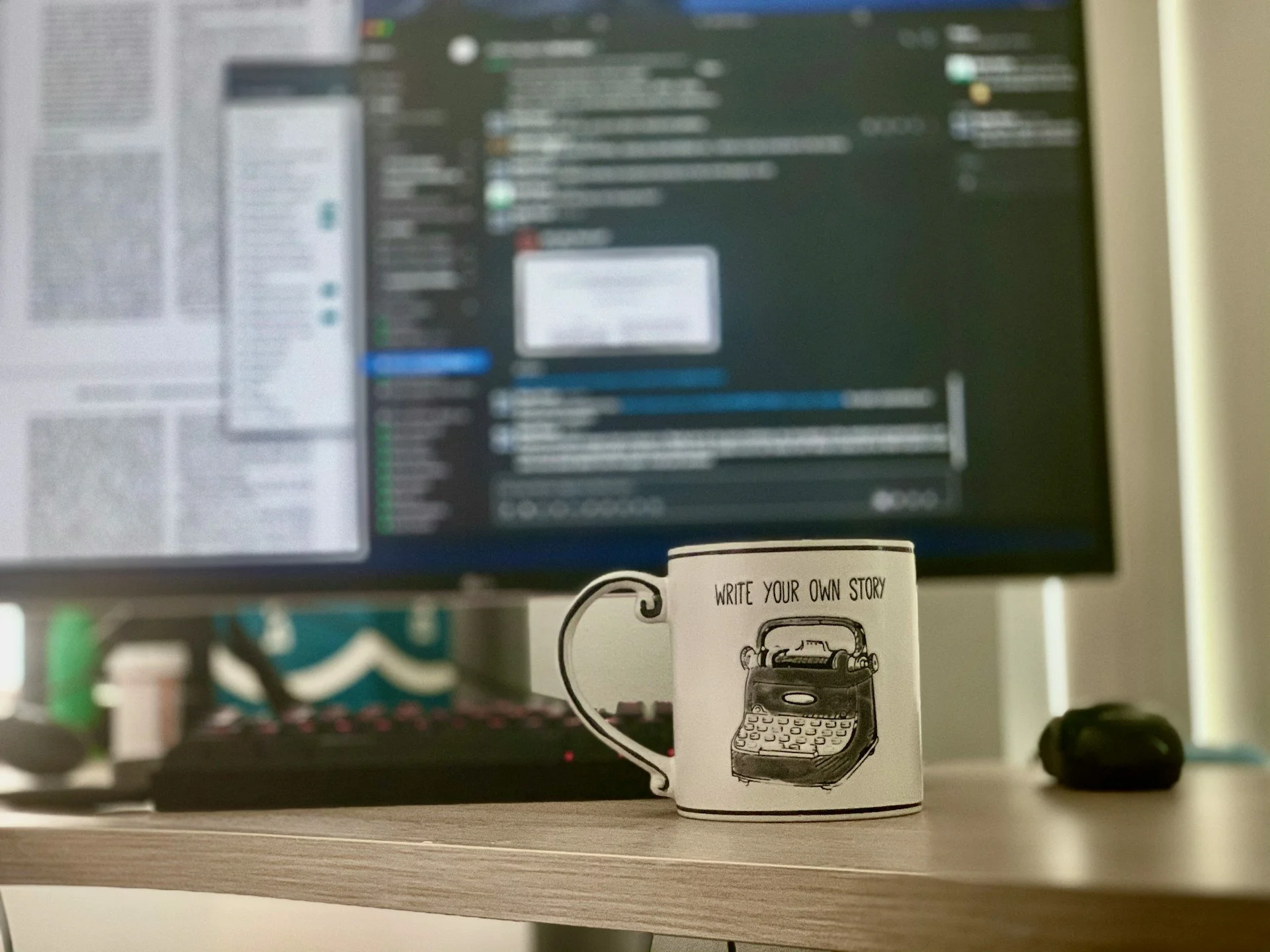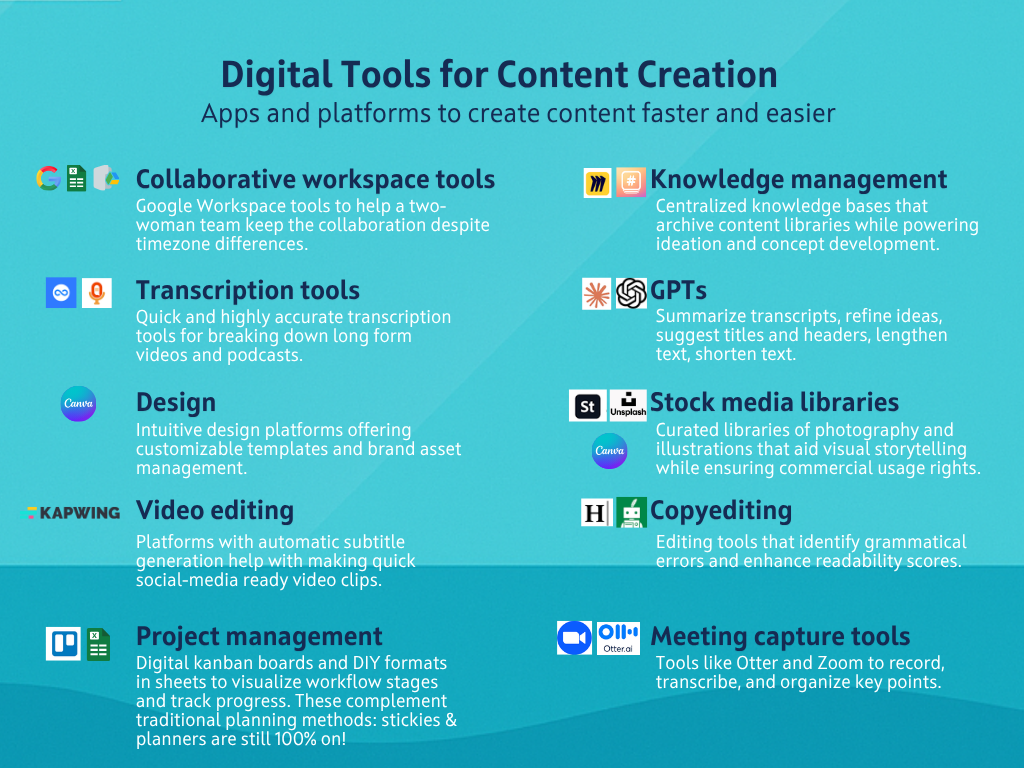Behind the Digital Curtain: How to Create Digital Content for Good (Part 2)
Part 2 of 3: From Insight to Impact: Systems, Tech, and Human Collaboration
A Guest Blog Series by Angela Mendoza Flores
Image credits: Srijan Tiwar | Unsplash
Welcome back! Ever wondered about the behind-the-scenes process of that social media post you just liked? Or the newsletter that went straight to your inbox? Or the video that you just watched?
I’m Angela, a digital content marketer from the Philippines, and I’ve had the incredible opportunity to support Dr. Tiffany Vora’s digital presence. She’s a scientist, keynote speaker, and a thought leader… and I get to help her share all of these awesome things on the internet!
In this three-part blog series, I’m spilling the beans on how Tiffany’s content actually gets made. This second installment zooms in on the juicy behind-the-scenes action (think: actual steps + tech) that take place before anyone sees a single piece of content (yes, including this one!).
Content Creation Superpowers
Where the magic happens - my home office!
I don’t have the superpowers of a magician who can pull a rabbit (or a newsletter) out of a hat. And while in some moments I really did wish I were a content fairy, I can’t make Tiffany’s content magically appear. And alas, I don’t trust ChatGPT enough to rely on it to churn all of Tiffany’s podcasts and schedule regurgitated content onto her digital channels.
Instead, my content superpowers are a little more grounded: a reliable mental model, a carefully curated tech stack, and a spark of joy. Now, if that sounds a bit less dazzling than interdimensional spell-casting—stay with me. The real magic is in the strategy. Here’s a peek into our playbook.
The mental model that I use for Tiffany’s content creation is inspired by the inbound marketing flywheel model. Plus a few elements of positive psychology, a field that I’ve been exploring for the past years. Compared to more traditional and linear models, the flywheel model is great for thought leaders who prioritize building trust over time, value community amplification, and aim to create lasting impact, not just transactions. And the little bursts of positive psychology is our way of differentiating from click bait and fear mongering tactics that loom large in digital marketing.
This framework then translates to an editorial workflow structure that ensures our two-woman team does not miss a beat, while staying adaptable. Here’s a super simplified overview of how our process works:
Events as the content anchor: Tiffany’s keynotes, podcasts, and panels serve as a “starting point” or first phase to our content strategy. These events are packed with insights that we distill into different formats.
Long-form content:
Blog and LinkedIn articles: The key takeaways from Tiffany’s talks become long-form blog articles on her website and LinkedIn (her primary social media platform). These pieces allow us to explore ideas more deeply and help the audience connect with the message on a more thoughtful level.
Newsletter: This is our experiment for 2025! Since social media algorithms don’t always favor organic content, our Substack newsletter ensures readers never miss Tiffany’s most valuable updates. This is also a great option for people who might be dialing back on social media but want to get access to bio-inspired and future-focused insights.
Short-form content:
Social media posts: People “hang out” on social media. And so we break down blog articles and other long-form content into smaller, digestible pieces tailored for LinkedIn, Instagram, and X. These posts make Tiffany’s insights accessible to a wider audience.
Videos and short clips: Many of Tiffany’s talks and interviews are recorded as long-form videos. I edit these into short, engaging clips for social media while keeping the message intact. Check out her YouTube channel where these videos are housed.
Loop back to new events and advocacy projects: Everything loops back to our mission: inspiring people to share, book, and support Tiffany's work. We’ve made it easy through platforms like Chuffed (for her voyage to Antarctica), Buy Me a Coffee, and Substack (the digital home of our newsletter). Once there is a new set of events, we repeat the process–with some improvements here and there of course!
Interestingly, from the digital audience’s perspective, the journey often begins with a single post—a video clip, a thought-provoking quote, or a short insight. That might lead them to explore Tiffany’s longer articles, podcasts, and videos. From there, some take the next step: joining an event, reaching out for a speaking engagement, or making a donation.
And even if it doesn’t loop back directly, it still matters. Maybe it sparked an idea. Or shifted a mindset. That, too, has an impact. And we love to hear from you about those impacts!
Working Better and Faster with Tech
Digital tools help us save time, reduce friction, and focus on the creative, strategic parts of content work. By leveraging the right tech, we extend Tiffany’s presence across multiple channels (we now have a Substack newsletter!), improve content quality (yay for video clips with accurate and readable subtitles with less manual work), and free up time for life outside the small screen.
Here are the key categories of tools that power our work:
Collaboration platforms like Google Workspace help us stay aligned across time zones and streamline everything from planning to file sharing.
Transcription software powered by AI like Turboscribe and Speechnotes turn audio and video into accurate text in minutes, which is a huge time-saver for content repurposing. (I’ve transcribed lectures from scratch before, and among the plethora of AI tools this one gives the vibes of Flash on a caffeine rush.)
Design tools such as Canva make it easy to create professional, on-brand visuals quickly.
Video editing tools with automated features like caption generation simplify post-production and ensure subtitles are both accurate and readable.
Project management tools like Trello keep me organized (because sometimes sticky notes are not enough).
Knowledge management systems such as Hypernotes let us build a searchable library of past content, while visual tools like Miro help us brainstorm and map out ideas creatively.
Generative AI tools like ChatGPT and Claude help summarize transcripts, refine ideas, and yes, give us the occasional pirate poetry we need to break a writer’s block.
Stock media resources including Adobe Stock and Unsplash provide high-quality imagery and ensure commercial usage rights.
Copyediting apps like Quillbot and Hemingway help tighten up writing when needed—though I’ll admit, I don’t always follow their advice!
Meeting capture tools like Otter AI summarize our alignment calls so we can focus on strategy instead of scribbling notes.
You don’t need to try every shiny new AI and software and add to your toolkit. What matters is being intentional—choosing tech that actually improves your workflow based on accuracy, reliability, and cost-effectiveness.
When we first started, many of these tools weren’t publicly available yet. Now, these tools enable us to work smarter, faster. Instead of getting slowed down by repetitive and extremely manual tasks, we have more time to refine our storytelling, try new creative approaches, and open up new platforms. Without burning out, we were able to add a YouTube channel and a Substack newsletter to Tiffany’s digital platforms.
Bringing It All Together: Skills That Make It Work
Image credits: Oli Lynch | Unsplash
Tools and processes are only part of the equation. A strong content strategy also relies on skills that bring structure, storytelling, and strategy together.
To keep everything on track, we hold monthly alignment sessions to review past events and plan for upcoming ones. I make suggestions for content, and together we refine the plan for the upcoming month. I’m also responsible for monitoring and interpreting our analytics data, which we use to design experiments on our channels. [Interjection from Tiffany: Angela also reminds me to get things done when we need them!]
Maybe my approach is a mix of a generalist and specialist—what’s often called a T-shaped skill set. I specialize in content marketing, but I also know about social media, SEO, email marketing. Moreover, I draw from fields like psychology, audience research, and design thinking to shape more compelling narratives. This combination allows me to see the big picture while executing finer details with care. Plus, it means that Tiffany can zoom in on technical aspects of the science and technology that we explore. We both play to our strengths!
And here’s an important piece of the puzzle: this work brings me joy! Without joy, it would be difficult to keep going at this for years, even with the help of AI and other tools. It’s deeply meaningful to be part of a mission that informs and empowers people. I’m grateful for the opportunity to contribute to something that helps others see possibilities, spark ideas, and take action.
No Replacement for Human Connection
Monthly check-ins with Tiffany: strategy, stories, and genuine connection (she knows when I’m having a good month or a rough one!)
I always look forward to our monthly check-ins. It’s a protected time when Tiffany and I plan, reflect, laugh, and connect not just as collaborators, but as human beings. As Tiffany often says, technology gives us superpowers, but it's meant to enhance—NOT replace—human connection. And we don’t just believe in that philosophy, we live it, every time we co-create content. She handles the science and I make sure these stories make it to the online world.
💡 Sustainable content isn’t just about systems or tools. It’s about purpose. For us, that means using digital storytelling to help more people imagine and build a better tomorrow.
That includes celebrating a whole lot of humanness in a tech-enabled world.
What’s Next
In Part 1 of this series, we explored the foundation of sustainable content creation. This second installment focused on workflow, technology, and the skills that bring it all together. In Part 3, we’ll talk about measuring impact and what happens after the content is out in the world.
About Tiffany
Dr. Tiffany Vora speaks, writes, and advises on how to harness technology to build the best possible future(s). She is an expert in biotech, health, & innovation.
For a full list of topics and collaboration opportunities, visit Tiffany’s Work Together webpage.
Get bio-inspiration and future-focused insights straight to your inbox by subscribing to her newsletter, Be Voracious. And be sure to follow Tiffany on LinkedIn, Instagram, Youtube, and X for conversations on building a better future.
Buy Tiffany a Cup of Coffee | Image credits: Irene Kredenets via Unsplash.
Donate = Impact
If this article sparked curiosity, inspired reflection, or made you smile, consider buying Tiffany a cup of coffee!
Your support will:
Spread your positive impact around the world
Empower Tiffany to protect time for impact-focused projects
Support her travel for pro bono events with students & nonprofits
Purchase carbon offsets for her travel
Create a legacy of sustainability with like-minded changemakers!
Join Tiffany on her mission by contributing through her Buy Me a Coffee page.






